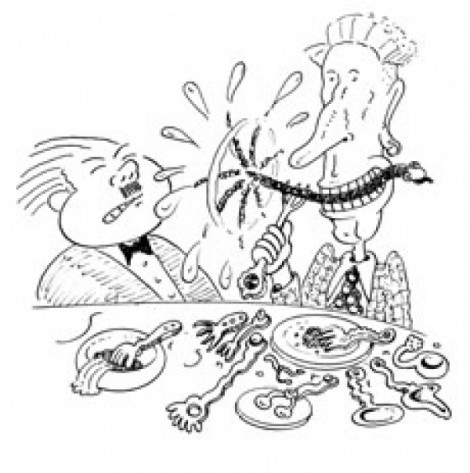
Dear Cecil: I was reading your enlightening discourse on the likelihood of people dining on mammoth [Sept. 14] and was somewhat dismayed to see you use the term “entree” to allude to the main course of a formal dinner. I understand that as you are writing for the Teeming Millions, who mostly live in the USA, you need to dumb things down a little, and using American idiom is a simple way of doing that. Can you explain to me, though, why Americans would use a word that so clearly does not fit the intended meaning? —Tony from Australia
Strong stuff, Tony, coming from a country that’s only in the last 20 years crawled from a primordial ooze of baked beans and Vegemite to lie panting on the shores of respectable cuisine. Even after recent advances, the Aussies are still trailing about a century behind the serious culinary world powers, so I’ll excuse you for not knowing what you’re talking about foodwise. What I won’t stand for, however, is some smart-ass impugning the intellect of the Teeming Millions—that’s my department. So cut the sass and acknowledge your ignorance, and I’ll dumb this down enough for you, too.
The issue here is that what Americans call an entree isn’t known by that name to English speakers elsewhere, who tend to stick with main course or main dish. Such people often figure entree (from French entrer, “to enter”) correctly refers only to a dish serving as an entrance to the meal—i.e., an appetizer, which is how it’s used in, e.g., Australia—and assume that the clueless Yanks are getting it wrong yet again. Not a crazy assumption, frankly, given recent world events—but, in this instance, it’s off base.
To see why, we go back roughly 100 years, to when the ritual of the formal dinner—devised in France and modified for use throughout the West—had come to the end of its golden age. A key venue for displays of refinement by the upper and middle classes, formal dining, though less elaborate than it had been 100 years before, retained a tricky set of rules governing everything from the order in which guests entered the room to which of a dozen utensils was most appropriate for eating conger eel.
By the late 1800s, a typical formal dinner in the U.K. ran to about six courses: soup, fish, entree, roast (or “joint”—no giggling), maybe another savory course (often a pudding), and dessert. As you’ll notice, the entree wasn’t the opening act. It was generally a “made” or highly prepared dish—possibly meat and vegetables, maybe sweetbreads or liver—as opposed to the more unadorned roast, but this distinction could be blurry; in the earliest use of entree cited by the Oxford English Dictionary, from 1759, the dish described is a roasted ham. So, while one could argue that the entree was the last of the preliminaries, it seems equally defensible to see it as the entrance into a series of what we’d now call main courses. Under main course, in fact, the OED has “one of a number of substantial dishes in a large menu,” and, in most cases, the entree was clearly substantial enough to qualify.
This interpretation prevailed in the U.S., where British conventions held sway, but as American menus became more streamlined in the early 20th century (old-school chefs were already griping about graceless, hurried modern dining as of 1905), some courses got the ax. The roast lost its automatic spot (possibly due in part to World War I meat rationing), the additional savory dish fell away, and soon enough the entree had gone from one of several main dishes to the last main dish standing.
Low-Cal Locale
I was wondering why someone decided to drop the kilo- from the calories listed on food labels. Isn’t that false advertising? —JPB, via e-mail
I like a righteous lawsuit as much as anyone, J, but there’s nothing here. For reasons too dull to list, calorie is defined as both 1. the amount of energy required to raise the temperature of one gram of water by one degree Celsius (the small or gram calorie) and 2. the amount of energy required to do the same for a kilogram of water (the large or kilogram calorie, or kilocalorie). Most foodstuffs have an energy content ranging from 4,000 to nearly 10,000 small calories per gram, and so early nutritionists found it easiest to make the large kind the default when discussing food intake. Yes, the UnS. could follow other countries’ lead and require food manufacturers to use kcal, for kilocalories, on their labels. But come on—one unit is a thousand times larger than the other, and most people never have reason to use the small one. If you’re counting your (large) calories but can’t figure out whether that can of soda really contains 150, .15, or 150,000 of them, you’ve got worse problems than your weight.
Comments, questions? Take it up with Cecil on the Straight Dope Message Board, StraightDope.com, or write him at the Chicago Reader, 11 E. Illinois, Chicago 60611.